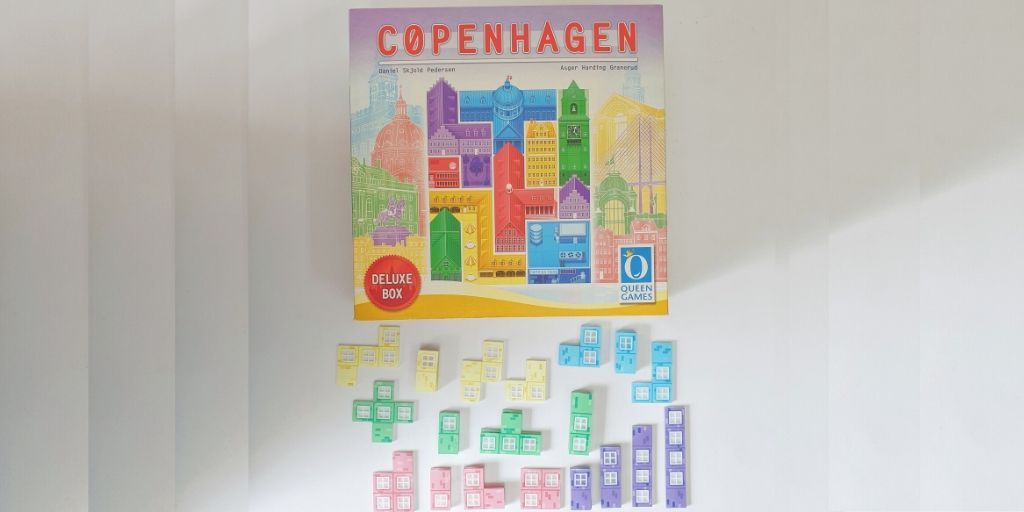Have you ever been to Copenhagen? For those who haven’t, me neither; it is in my bucket list, though. I hope I can visit this town at some point in my life! In the meantime, Copenhagen, the board game, shall make do to satisfy my wanderlust. People say that “Nyhavn” or the New Harbor in Copenhagen is famous for its colourful buildings along the waterside and Copenhagen (the board game) aims to capture that scenery and deliver it to the players in a simple, yet engaging gameplay.
About Copenhagen (again, the board game, not the city)
Copenhagen is a card-taking, tile-placement game for 2-4 players. Here, players take turn to create the façade of a building by taking polyomino tiles and arrange them on the player board, scoring points when they complete a row or column. Players can gain special ability tiles to help them throughout the game by fulfilling specific conditions. Each polyomino tiles are limited, so planning and tile placement are key to score more points!
Setting up the game
Each player takes a player board and place it in front of them. This will be the “construction site” to build their own façade. Then, set up the middle board and place the deck of cards, setting aside the end game card (the little mermaid card) for the first round. Seven cards are then revealed in a clockwise direction around the middle board. Separate all the building tiles according to its colour and shape so it is visible to all players. The same applies to the special ability tiles; separate it according to its picture. Give the players their starting cards according to the turn order and the “any cards” ability tile and you are good to go!
Gameplay
The objective of the game is to score the most points by completing a row or column on the player board. A row will score one point, whereas a column will score two points. If the player manages to create a row full of windows, the player will score two points instead. If a column consists of windows only, that player will score four(!) points instead.
During each of their turns, players can take one of the two available actions. First, in “take cards” action, players take two adjacent cards from the middle board and place the cards in their hand; there’s a maximum hand of seven cards. In “construct façade” action, players discard their cards to take a tile with matching colours from the common supply. The size of the tile taken depends on the number of discarded cards.
After a tile is taken, that tile must be placed immediately on the player board, starting from the bottom.
Each subsequent tiles must be placed either on the bottom or directly on top of previously placed tiles. If a player places a new tile that touches a tile of the same colour on his or her player board, that player discards one less card to take the new tile. Whenever players take action, they may opt to use the ability tiles they own to get special effects. Once a tile has been used, that tile will be flipped to the inactive side until it is refreshed.
When players place a tile on their player board, players may cover one of the “Coat of Arms” on their personal board or complete a row with “Coat of Arms”. When a player does so, he/she may gain a benefit. The first benefit is choosing an additional special ability tile (Additional card, Construction discount, Change of colours, and Both action). A player cannot have two tiles that have the same ability. Alternatively, instead of taking new tiles, the player may choose to refresh their ability tiles. Another possible option for the players is to take and immediately place a single colourless special window tile on the player board.
When the deck runs out for the first time, the discard pile is then shuffled to create a new deck. The little mermaid card will be included this time around as the end game marker. Take nine cards from the deck, shuffle them together with the end game card, and place it on the bottom of the deck. The game immediately ends after a player reaches twelve points OR when the little mermaid card is revealed. The player with the highest point wins! If there is a tie, the player with the fewest empty spaces wins. If there is still a tie, the tied players share the victory.
Personal Opinion
Simple yet elegant; that sums up my opinion about Copenhagen. I have always been a sucker for colourful polyominoes games, so this opinion may be a tad subjective. But I still think Queen Games has published a very good one, especially for new players. I can safely categorise this game into the family department. The dynamic duo, Asger Harding Granerud and Daniel Skjold Pedersen, made and drafted the rules very easy to understand. This explains the medium-light, 1,79 out of 5,00 complexity rating in its BGG entry. On top of that, gameplay-wise, it is neat and straightforward.
If we are talking about the components, I was lucky enough to get my hands on the Copenhagen: Deluxe Edition. It is absolutely stunning. The acrylic tiles were beautifully made with vibrant colours and transparent windows, making the façade you create much more amazing than using normal cardboard pieces. However, for you guys who missed the deluxe or can only afford the retailer edition, there’s nothing you miss from the Deluxe besides the additional point on the cosmetic. Just like the typical Queen Games release, they actually also offer some nice, playable promos for ‘relic hunters’.
On the other hand, Copenhagen does not really offer anything “new” to the table, sadly. Don’t get me wrong, it’s still worth your time and some spaces on your shelf. It’s just, there are already a ton of card-taking and tile placement games out there, and Copenhagen does not really give any sort of different vibes compared to those. I cannot shake off the feeling like “Oh, so this part works like game A, while the other part works like game B” throughout the game. Nevertheless, there’s nothing new under the sun, right?
This might be a deal-breaker for intermediate or veteran players, but I feel like this is actually intended by the developers because this game is designed with new players in mind, maybe. Many popular gateway games utilize the same mechanics, so it is easier to teach new players if they have already known or tried similar games. I was also a bit surprised at first by how fast the game went, but after playing it a bit more, I feel the duration of the game is a good 35-minute-session. That number is actually the golden ratio here; players are still given enough time to plan their moves and fill their board without dragging the game too long.
Conclusion
If you are looking for a light and beautiful game, then Copenhagen is the game for you! Stunning theme, simple gameplay, and attractive components will ensure Copenhagen to hit the table a lot, especially if you want to introduce tabletop games to new players.










